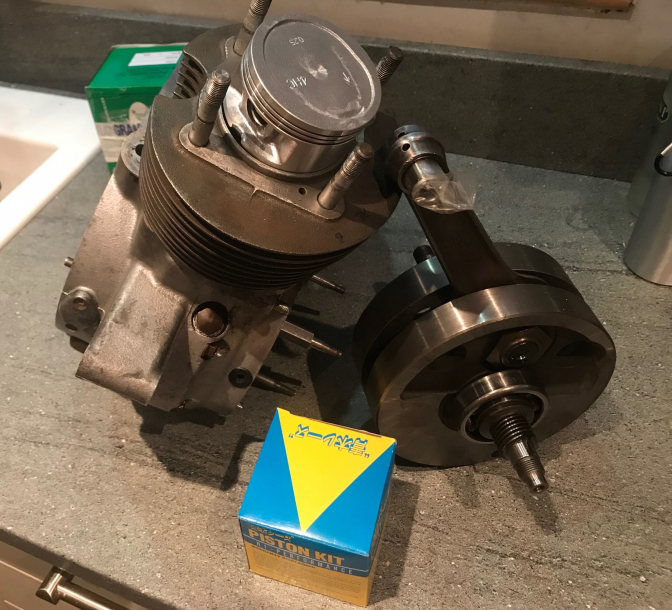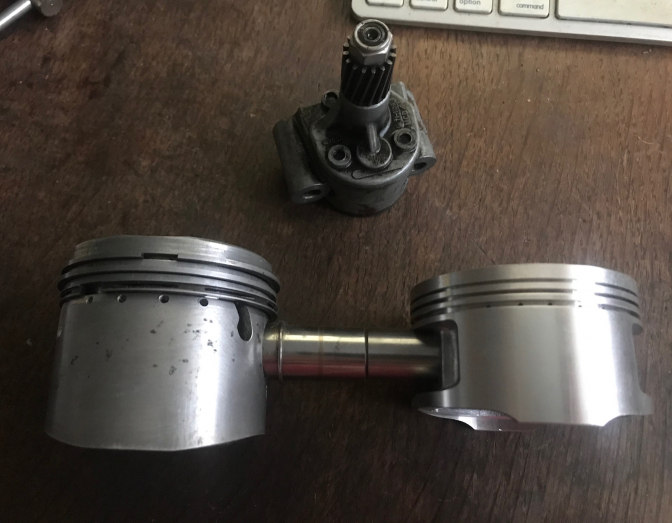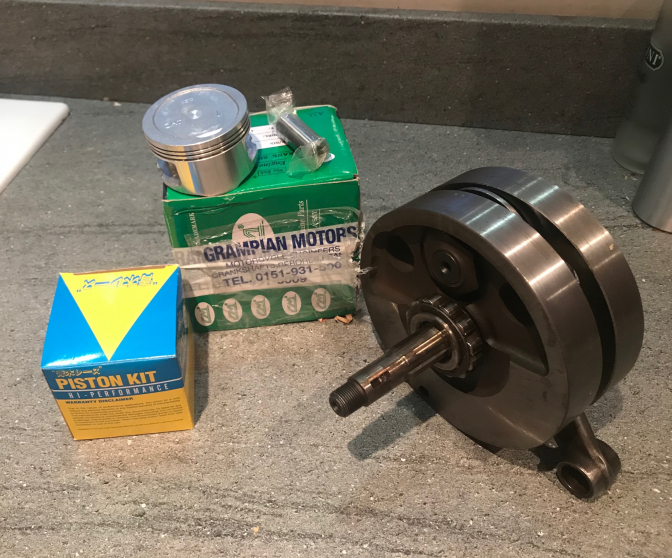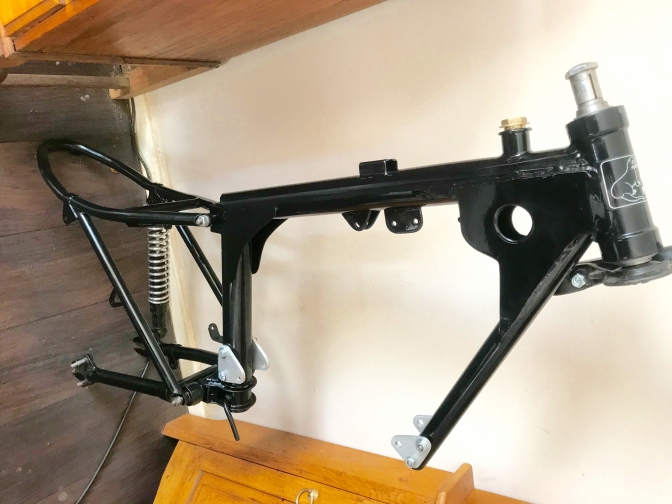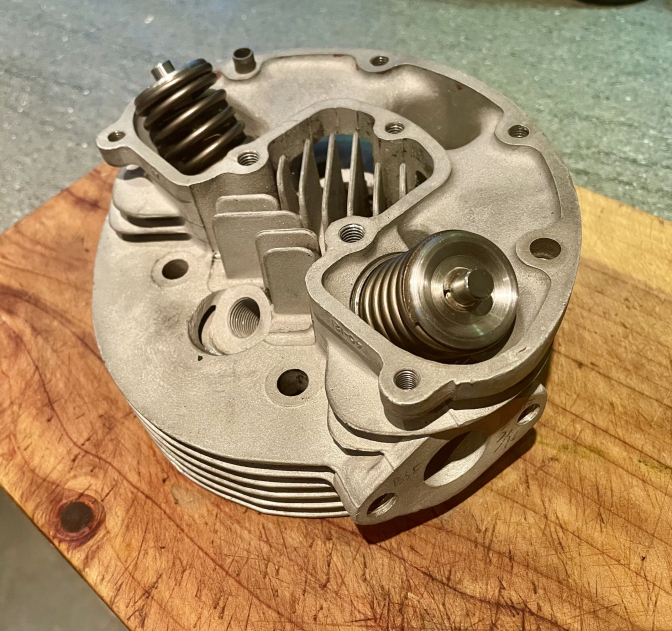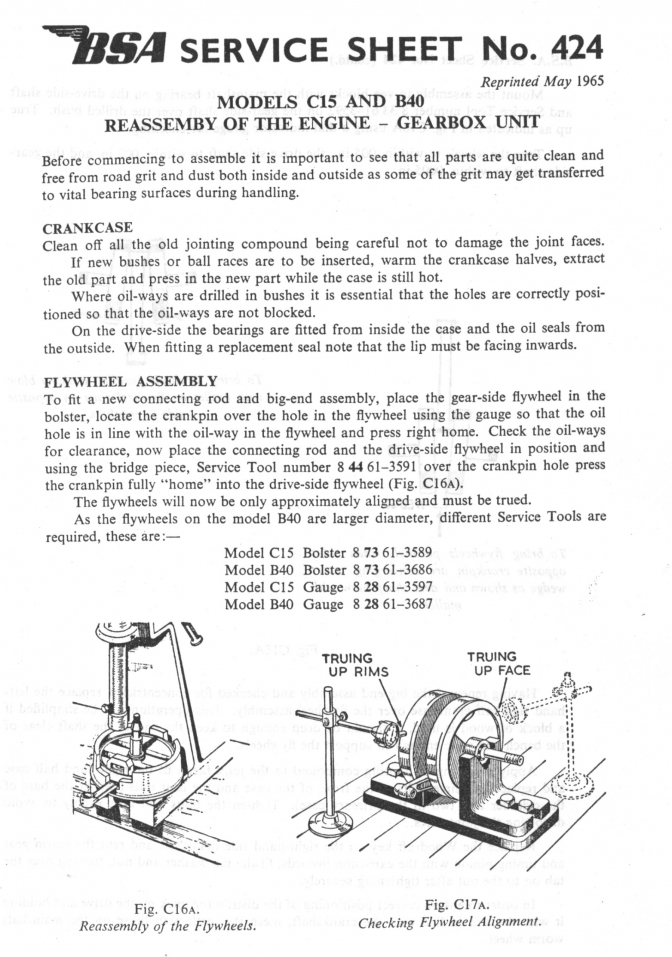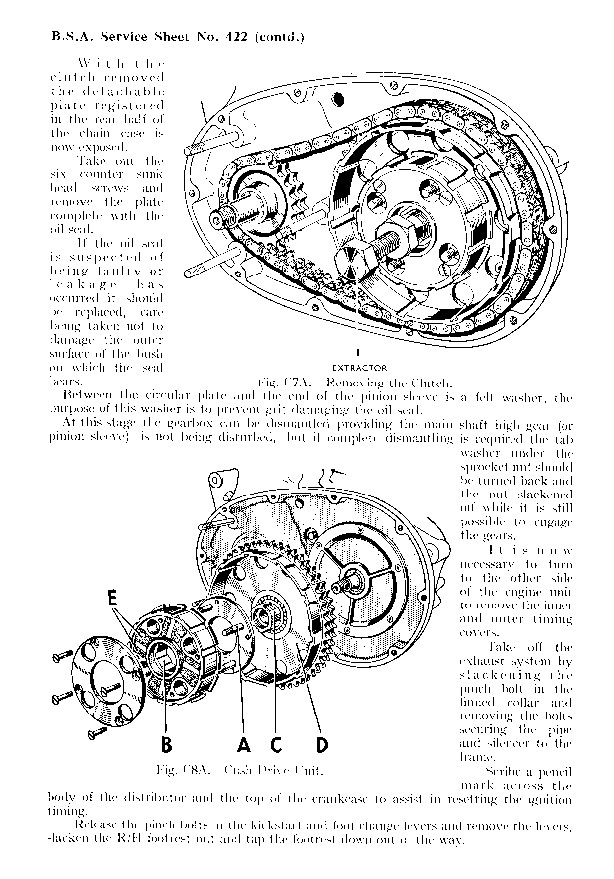The best BSA Quarter litre plus engine that we can build for trials, with a few more options. Now even a Long Stroke.
20/11/2020...
Well it has been ten years, Phewww that slipped by quick... I now have several BSA engine builds behind me and still have the 280 G type engine on the bench nearly finished, time just flew bye, when you are stuck for this, that, and the other small parts, and I have even ended up making small engine parts that I could not find, because I was sick of waiting for the items to appear on that site.... I have three BSA converted to F type engines on the bench, and another couple in the stores. Also I am working on two B25 engines and a third in the pipeline. But speaking to Pete Kirby, and Dave Wood, I have also decided to build a long stroke 337cc engine to give me interest in this second "Lock-down" that is probably running into a third shortly... So I have started to collect the parts for this build... I have a set of crankcases and a BSA B44 set of "as new" flywheels along with the oil pump from the same engine, as I know that was good because of the condition of the flywheels big-end... I was considering an alloy barrel for the build but now plump-et for a iron one as a safer bet being bored out to 69.25 mm. So what do I do for a piston? Well I better explain the principle of the long stroke engine first. By using the B44 flywheel assembly you get an added 20 mm of stroke from the 70 mm of the C15-B40, to the 90 mm stroke of the B44...B50... Out came the Rupert Book to check on every which way, and that, to see if it was all possible... I know it is, because Pete "Kirby" has built several of these engines including the one for Dave Wood. If you use a "Slipper type" piston for your build you will get away we hope without altering the C15 barrel length, although you may have to ease the skirt of the piston slightly to stop it touching the flywheels at bottom dead centre. As I say this is using C15 G type or B25 crankcases for the right barrel stud spacing... So far you are saying that looks easy! But you know in the back of your mind there will be complications I know I can ask Pete, but this is my build and finding out these difficulties is part of the fun... Pete did say that he used a piston from a early Honda Fireblade for his own bike build but these pistons are 70 mm wide, and I wanted to stick with 69 mm like Dave's engine, this had a Gilera piston fitted when it was first built, but this is no longer available... So speaking to Dave he said he had replaced that piston with one from a Yamaha 250YP Majesty scooter, at I now know 69.025 mm, and this piston came from Jim Nicholson at Grampian Motors in Liverpool. So I emailed Jim (what a nice chap) and he was straight back to me saying they only had oversize's, well they would do thinking about it, as they are probably the company that do the most motorcycle and classic car re-bores in the country and have their own piston manufacturing factory in Taiwan "Mitaka"... and sell their own make boring bars. So yesterday on the 19th Nov 2020. I rang Jim and did the deal for the piston. "Get it to you tomorrow" he said. Sure enough 8,45 am, knock on the door with a man with a Grampian Motors box in his hand, good service Jim, and within the lock-down... So we now have the piston for the project as well.. A standard BSA C15 small bore "40-121" cylinder head will be used initially as that is what Dave has on his motor and a 22 mm carb, and he says his motor will pull away from a standing start in third and climb a steep bank no-problem... This is what we want, and I have liked that motor since I first saw the bike in the Isle Of Man all those years ago now. I think I have a gear-cluster and most of the parts to complete that, but will have to check the ratios... Clutch and drive side, well Pete Kirby of course and it would have been here if it was not for this lock-down... ~~~~~~~
Here you can clearly see the difference in the stack height of the two pistons... the one on the left is from a BSA B25 engine, and the one on the right is the 69.025.. Yamaha YP 250 Majesty scooter piston... What we need to achieve is 20mm clearance difference both top and bottom of the stroke IE: the piston from the centre of the gudgeon (Wrist) pin needs to be 20 mm less in measurement top and bottom than the B25 piston that runs a 70 mm stroke... Hope you can understand this... We will see how things stack up, we can adjust the top dead centre height if necessary by fitting a small spacer under the barrel, but it needs to be small otherwise push-rods and push-rod tunnel have to be lengthened along with barrel studs. and this extra height will alter frame head steady fixings too.
Thank you Jim from Grampian Motors, old fashioned first class service from a professional who knows his stuff... ~~~~~~~
It is all very well having a first class engine I can hear you say, but what are you going to use it in? Well it has got to be my favourite Foster Otter frame the one with the Triumph Mountain Cub rear end and swinging arm...
More Later... On this build...
20/02/2024... New Hy-Brid BSA trials engine... Over the past couple of weeks I have collected all of the parts to build another engine for one of the Foster BSA Otter's in build... I have based this engine on a 1967 BSA C25 that were mostly sent to the USA... the crank is from a 1970 B25 with better conecting rod and will run a roller bearing on the drive side as an update... the C25 engines only had two ball bearings for that year... gears are a set from a B40 GB engine that I have... Cylinder barrel is a shorn into C15 shape B25 and a B25 standard piston... the cylinder head is a small inlet port BSA C15.. with steel polished inlet guide and bronze exhaust guide from a B25... this needed a one off spring retaining washer to be made on the lathe two hours work to go onto the time sheet... Most of the internal engine parts I have sourced from dealers on eBay that I have delt with before... I first bought the crankcases and bolted on the sump plate and oil pump that I had, then searched the pages for the rest, starting with a complete crank assembly from our friend Graham Wright...I was thinking of the fork's saga when I had one of those happenings again from Andrew Bateman where the cam shaft and followers were sent to another buyer where... I got a brake cylinder... the man that got my cam and followers was not happy and would not return them...to Andrew, so I had the back and forth with the ebay messages... and in the end had to buy more followers, and beg Andrew the seller to send me his other camshaft that was on the site... So good fun while I was trying to sort the stuff for Telford show...
The Hy-Brid engine Cylinder head...
I now have most of the parts for the complete engine build, even today a rockerbox assembly has arrived as good as new for £10 this seems to be another engine that wants to put its self together because finding all the parts as seemed to be easy... but I must not speak too soon... More Later.
Ten Years Ago... 20/10/2010... OK... Its been a long time coming but we need to get this act together ? Because it is getting increasingly difficult to now get parts to build an engine like this with the parts available, things are just getting more expensive daily.
So we have a pair of late type crankcases, and a new O/S timing cover, inner, and outer. I know that there are still C and B engines about with the timing side bush, and as you know I have made a conversion on the Scott Ellis bike engine, and fitted Alpha conversions into another three. But for this build we are going to set off and build the best engine we can with parts that are available, and to tune this engine to what we think would give the best power for a trials bike. The capacity of the engine will probably be near to 280cc or just under, and we are going to try and build in a bit better bottom end torque. To this end, I am getting a pair of steel flywheels machined up and will probably use a Alpha big end and rod, I see no point going for the more expensive rods available, as in the end this is only a trials engine. We could even use a B25 flywheel assembly as others have done, with good results. Well that has started the page, and I just hope someone comes up with a camera for me this Christmas? 29/12/10. Still no camera, but it is my birthday next week!
Well I thought I would publish this letter from Martin as it will give us all something to think about while I am collecting the engine parts,or making the (Flywheels) etc. I spent hour's yesterday trying to track down parts that I know exist, but it is not easy! I think I have said before you think everyone is on the Net, but they are NOT, especially the backstreet engineers that turn these parts out. But that is my job isn't it? to find them.
Here is what Martin sent me.
Hi Charlie, I sent a comment through the web site but it limited the number of characters I could use. My comment was that you have given us great info on the frame and cycle parts but to do justice to the frame and the work that goes into building such a bike, we need to know how to make the engine work properly for trials. The standard engine isn't very good and I understand that although there are a number of engine builders in the Midlands, they keep their secrets close to their hearts. I assume the engine modifications are possibly different for the C15, B25, and B40.?
Some of the answers to recommended engine mods are already well known through Trials Central such as
-What ignition system? PVL most popular (any others?) (Any adjustment to PVL's recommended timing for the above engines, e.g. slight advance or retard?) Charlie.:> There is now Electrex-World systems that are a lot like PVL and work just as well And spring from the "Horsepower" units made in the Netherlands. But to be honest although they both work very well and are reliable, they are still only like a unit fitted to your lawn mower, or chain saw... I still in some ways prefer the Boyer Bransdon Trial ignition unit, I have this fitted to my MK1 Faber "Otter" with C15 G engine, and that unit plonk's a lot better than the ones fitted with PVL or Electrex-World. And is fuelled by the Lucas alternator fitted as standard, although being slightly heavier the bigger rotor may help the plonk situation, it just seems a lot more free running.
We don't really want to go down the totally electronic unit fitted to modern day trials bike with different mapping settings do we.
Some people still run total discharge coil ignition and with the new lithium batteries that you now can get are tiny and keep their charge for a long time, these figure strongly on the Magic box type ignition fitted to Classic Scrambles bikes.
-Gearbox internals ... set of trials gears (very rare so what else?). Charlie:> To be honest standard or close ratio gears are just as well for today's trials on pocket sized courses. The only real advantage that wide ratio gears had was to give you a high enough gear for the road work in trials of the past era's. -engine sprocket 18 tooth... -G/box 13?? -rear wheel ?? Charlie:> 56-65. -Carb Concentric type and jet sizes (any other carbs?)
Charlie:> Amal or even Wassell now 22-26 mm. Or you could go for the New Amalminum carb more expencive but helps combat the Ethanol.
A better way to combat this is to use Aspen Fuel it may be expensive but you can then totaly forget the trouble you will have with carburation and other problems using pump fuel. A better bet and cheaper seems to be the Mikuni VM 22 carb as fitted to pit bikes. made in Japan and proved by how many fit them to Triumph Tiger Cubs.
Forget you can't use them in Scotland, One trial, so who cares. Martin:> Other questions I can think of for which I haven't seen answers in TC are:
-What compression ratio for each of above engines. (I heard of Triumph pistons in B25s, but is this as much to get the ratio right as increase engine size?). Charlie:> Look the only way you can know if the bike you are riding suits you is to try different things until it does. The Works BSA boys and come to that Triumph, always ran high compression piston's and said that it smoothed the motor out better. But do you know what gearing they were using? Most of the trials then were over seventy miles of road work as-well as the sections, so there had to be a compromise. Martin:> -The B25 flywheel is smaller than the C15's, should it be increased to match the C15, should it be made as big as possible, (I increased mine by 1/2 inch in dia), or can a C15 crank fit a B25?
Charlie:>
Anything is possible if you have the time to do the conversion, so yes. The B25 flywheels are actually heavier and have more inertia than the BSA C15. And that is why some of the UK Midlands tuners are using these flywheels in preference to those that were fitted as standard, and even at at least one in the Cotswolds.
Martin:> -What relative benefit is there in reducing both inlet valve size and inlet port diameter?
Charlie:> Same again Martin personal preference. I have fitted sleeves into Amal carbs to reduce the size of the venturi. but after taking it back out I could feel little difference. Same with valves and proved by the BSA comp shop trying to get more traction from the B40 engines. Reducing the valve size does not always give you more torque and bottom end...
-What is best cam and valve timing? R. Bacon book says C15Ts had different cams in different years. Which is best? Charlie:> Strictly speaking the valve timing for trials do not need long dwell periods after the initial opening and shutting, nor is there any advantage of any higher lift, therefore there is nothing wrong with the standard road cam... But if you are using the B25 as a basis for your trials machine and have to use the big foot cam followers use the softest you can get. You can run an early C15 Dizzy cam and radised followers with a bit of modification. Martin:> How is the opening point defined, is it just when the tappet clearance is zero or at some specified amount of valve lift? The standard B25 inlet opens around 52 deg BTDC, I thought a trials engine would need closer to 30 deg. Charlie:> The valve is open when the outside or inside pressure is allowed to escape, if the head and valves have been gas-flowed this is going to occur earlier than a standard head and valves, it is just down to how much performance enhancement you think you need on a trials motorcycle to get the performance you require of it. Martin:> What are relative benefits of soft cams with high compression versus hard cams with low compression?
Charlie:> I think we have covered that subject, it is down to personal preference, and what works best for you does not necessarily suit someone else. Martin:> - Recommended exhaust length and silencer type to keep engine quiet without strangling it? Charlie:> If we are talking BSA C15 B40, just look at the length of header pipe and silencer layout on the Scott Ellis bike and the Foster Otters. Sharp short pipes and a resonator expansion box with a little silencing. We know that for a four-stroke competition engine you need a long megaphone type system with a slight reverse for ultimate torque, but for a trials bike why bother get the gasses out as quick as you can with little fuss, and little restriction. You can have elaborate expansion boxes and reversed flow silencers but a packing to deaden the sound waves is all that is rely necessary. Martin:> - Any improvements to the lubrication system other than in-line filters? Charlie:> There is only one thing you need to do and that is keep the oil clean, change it often and if you run a B25 type engine, fit a filter of the canister type, all engines need a filter of some sort though how ever long they run for one week end or 50 in a year.
Martin:> I am sure your readers could think up more questions. Charlie:> I try to answer all of the questions that people send into me, if I dont know, then I tell them I will find out for them. It is pointless making things up.
Regards Martin de Vries
11/06/2011...
Has I have said on the news page I have been studying what the old works riders said about the best BSA C15 trials engine. And most of them thought the older motors had better softer power, for a trials bike. But we have our BSA"G" type bottom end, so I need to find other ways of softening the engine. I have been told that if you use an Honda industrial engine piston, this can help, I am researching this at the moment. And has I have said again on the news page, I am getting the pattern for the alloy barrel started again.(now not necessary we have RayBox Engineering) I can tell you that a small valved C15 (40-121) cylinder head will be used, and experimental camshaft, and followers, will be used. The profile for the camshaft will be based on the camshaft that I have, taken from GOV132 by Don Morley. So It may work with a similar profile on a BSA or it may not.
29/07/2016. I now need to build this engine for a New frame that is about to be constructed. Not a lot has changed with the thinking from 2011. There is now a supply of alloy C15 and B40 barrels so that solves that problem? Well if the steel barrel is bored out to except the Triumph piston to increase the capacity to 268-70cc, and a few holes drilled through the finning, placed on the scales there is hardly any difference in the weight. So a steel barrel may still be used. After doing more research on the Honda Industrial engine piston that Idea was shelved, although I did look into using a piston from a Kawasaki Z1000. I am going to use an ex works Dizzy camshaft in the engine to try it, this has had slight modification to allow it to fit, and has been equipped with a Alloy timing wheel.
26/06/2011 Here is a bit of information from one of our Canadian friend's.
Hi Charlie, I was just reading your page on C15 engines, I live in Canada but I am a Brit. We have vintage trials here and one of the guys rides a B25 but he fitted a C15 crank and top end to it. He is an engineer so had the tools to do the job, he converted the big end oil feed to quill type and made up a spacer to raise the barrel. The bike was transformed and would plonk and pull from zero revs. I talked to Jeff Smith about this and he reckoned the conrod length (70mm) and ratio (8.5 .1) had a lot to do with the C15 being a better engine. Just to let you know we enjoy reading about your exploits and your skills with frame building and machine work. Thank's, Derek Cherry.
Charlie:> Thank you Derek.
I have this past couple of weeks been scanning the pages of eBay to find the bits I need to assemble the engine. I am amazed at how difficult it is to get BSA B and C engine parts, and how expensive they are becoming. Anyway parts are on the way, and I already seem to have spent the budget, but has I said the project was never going to be cheap. Looks like I should use one of Pete Kirby's belt drive clutch units, if I can beat him down a bit on price? ( Look at all the free advertising you will get on this site Pete!).
Anyway I will start to build the bottom end up this week, and from advice from someone who knows, I am now using a crank assembly from a BSA unit but not what you would think for a C15. (It was a skimmed B40) Pictures will accompany the build. 29/07/2016. Yes I did start the build way-back then, and then the project got shelved again. So a quick recap of what we intend to put into this motor, yes it has been a long time but the world moves on and more information has come to light in this period of time. B25 crankcases are now being used along with a B25 crankshaft assembly. As I say the Dizzy camshaft is going to be tried, along with a couple of barrel and head combinations, gears will be the new road cluster I have, connected to a Pete Kirby belt drive clutch conversion. Mikuni VM22 carb and short silencer header unit... Ignition well I am going to plump for the Boyer Bransden I think, and see how it runs.
Anyway more later, now I am on the case and need the motor. And I may do some Britannia Motorcycles type Video's with my Go-Pro and Cannon, of the build up. with all the snags that will occur like Mike gets.
Video here.
Back to 31/01/2012... OK... Call me thick then, I have just spent some time today going through old email's from you guy's, and a new one. And have now realised that this engine build page was not live well , sorry I must have thrown the switch so to speak, and I hope it is back on now. Well a quick update, I now have all, of the parts to build this engine and the other two that I am rebuilding. That is the one from the Nick Draper bike, and this engine is interesting inside, and has shown me the way to go with the NEW engine... the other rebuild is the Scott Ellis bike engine, I have obtained a better pair of crankcases for this motor, along with an updated clutch. The New motor will have a Pete Kirby Diaphragm clutch if he will sell me one? Dave Wood's bike also has one of these fitted. The bearing's I have been waiting for are now here, so if the weather gets a bit warmer next week I will get the spanner's twirling, and the camera clicking !!
More Later and now on with the build again in 2016...
...
BSA Service sheet 424.
... BSA Service sheet 422.
BSA B25 Engine assembly video. this is with the four plate clutch and before the 1970-1 five plate conversion. The five plate did away with the flange on the centre, and another plate was sat into the basket. The centre had a bigger flange with a copper faced thrust washer copper side up sitting onto this. The back of the basket had a bigger machined area to accommodate this New thrust area.
You can do this conversion with a four plate clutch by just removing the hub centre spigot. But without a thrust washer and a smaller flange surface this does tend to wear rapidly. The flange washer part Number and even obtaining one is very elusive but if you have a Large flange five plate clutch you need that thrust washer. Check out the "Clutching at Straws" Page...
More Engine information Later... updat2023...06...
|


